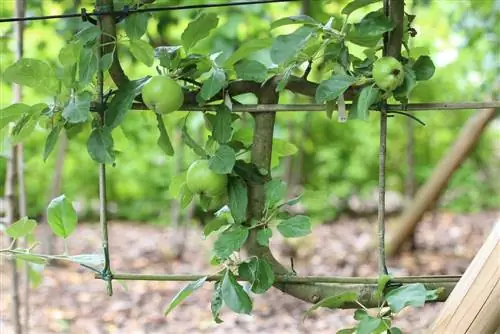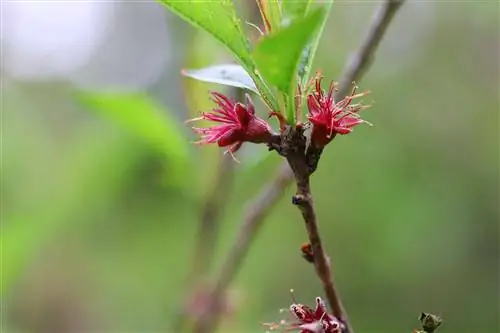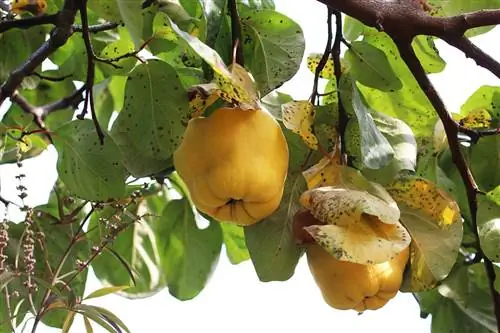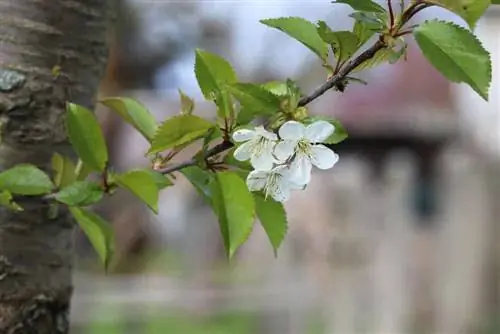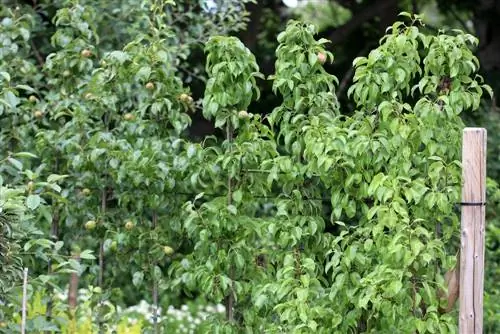- Author admin [email protected].
- Public 2023-12-17 03:39.
- Last modified 2025-01-24 12:45.
Espalier fruit trees only require a small amount of space and are therefore suitable for small gardens where normal fruit trees cannot grow. This can be used to decorate unsightly walls and walls. However, training the high-maintenance fruit trees on espaliers requires a lot of work, especially in the beginning. In addition, the planting distance and the site conditions are extremely important for good growth and a rich harvest.
Trellis shapes
Espaliers are ideal for planting delicious fruit in small spaces with little space. The espalier fruit can either serve as a supplement or act as a replacement if there is no suitable location for fruit trees in the garden. Espaliered fruit trees decorate the garden landscape and enchant with delicate inflorescences in spring. Then in late summer or autumn the juicy, sweet fruits of the selected fruit variety follow. Even in winter, when only the bare branches can be seen on the trellis, they still have a decorative effect. When buying or making your own trellis shapes, it is important to pay attention to a stable construction. Ultimately, the trellis framework must be able to support the constantly growing tree for a long time. If you choose a natural material, you should make sure that the bamboo or wood is well seasoned. Otherwise it can quickly start to rot.
- There are various construction shapes to choose from
- Espalier frameworks made of bamboo, wood, wire and steel are possible
- Materials can be combined with each other
- Choose espalier shapes according to the location
- U-trellises and double-U-trellises are very classic
- One-arm and two-arm trellis forms are ideal for confined locations
- Fans and circle palmettes look visually interesting
- Forked trellises and V-trellises are suitable for larger spaces
- Attach the trellis approx. 10 cm from the house wall
- Adjust at a height of about 40-50 cm from the floor
Suitable types of fruit
Basically all types of fruit are suitable as espalier fruit trees, which are also normally cultivated in local gardens. However, the respective circumstances and regional location conditions must always be taken into account. Some fruit trees need intense sunlight all day long. On the other hand, with other types of fruit, too much sun can have a detrimental effect and lead to burns. Therefore, these aspects must be taken into account before making a selection, otherwise the tree cannot thrive and produce delicious fruits.
- Apples and pears are traditional espalier fruit trees
- Peaches depend on lots of warming sun
- Grapes need a sunny location and warmth
- Robust sour cherries even grow on north walls
- Apricots do not tolerate cold
- Figs are also heat-loving fruits
- Kiwis bring an exotic flair to the garden
- Blackberries climb high up the trellises
Location
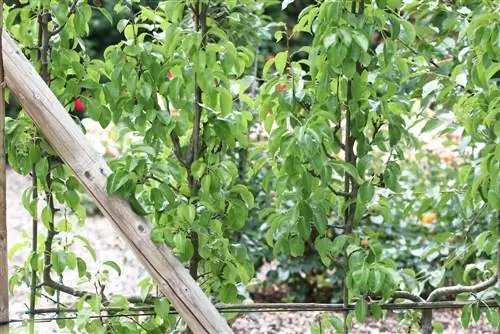
As a rule, espaliered fruit trees are grown on sunny walls and walls, as the warmth ensures higher harvest yields. The masonry stores the sun's heat during the day and then gradually releases it again. In this way, the espaliered fruit tree is protected from late frosts. In addition, the fruits are only slightly shaded by their own foliage as they grow along the spread branches of the trellis. If the local conditions are not optimal, the choice of location can be adapted to the local conditions with a little skill. However, only a few types of fruit can tolerate cold and dark conditions. In addition, fruit trees on espaliers are very susceptible to strong winds, which is why they rely on special protective measures. When selecting the espalier shapes for the respective location, the space available must be taken into account.
- South-facing house walls and garden walls are ideal
- Native apple and pear trees prefer west and southwest walls
- Any espalier shape is possible for windowless walls
- For house walls with windows and doors, adapt the trellis shape to it
- Always pay attention to structural conditions
- Pay attention to wind-protected locations
- High and wide masonry blocks cold winds
- Trellis fruit trees are happy about rain protection
- A slightly protruding roof is good
- Espaliers can also be installed free-standing in the garden
- It is possible to construct trellis shapes as arcades
- Good for demarcating garden areas and beds
- Privacy protection on the fence with espaliered trees is also possible
Tip:
If you don't have a garden but have a large terrace or a spacious balcony, you can also cultivate espaliered fruit trees in a container if there is enough space.
Plants & Plant Spacing
If you want to make planting easier, buy pre-cultivated espaliered fruit trees. Although these make work much easier, the price is much higher. If you have time and patience, you can train normal fruit trees yourself in the desired espalier shape. Every espalier fruit tree needs sufficient planting distance, both from the neighboring trees and from the wall. A distance from the wall is important so that the wood is also ventilated from behind. However, the distance to the neighbor depends on the type of fruit and its growth habit. Fruit trees or vine plants that grow narrowly upwards need less spacing, while varieties that grow narrowly in width need more spacing. Espalier fruit trees grow much more compactly and only form a relatively small root ball. That's why they can also be cultivated in a planter.
- Good time to plant is from October to March
- Only expose on frost-free days
- Dig a sufficiently large planting hole
- Should be twice as tall and wide as the root ball
- Maintain a distance of 30 cm from the house wall
- Mix the excavated material with plenty of compost
- Then insert the tree
- Then fill the planting hole with excavated material
- Tread well and water thoroughly
- A distance of around 2-2.5 m from the neighbor is ideal
- Slender tendril plants need less spacing
Cutting
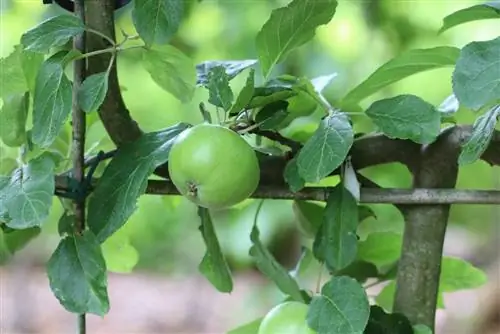
Thanks to the good pruning tolerance and the diligent work of the gardener, the fruit trees can be shaped into the desired shape over time. With the young espalier fruit tree, cutting begins immediately after planting, with the so-called planting cut. Then the tree has time throughout the spring and summer months to diligently sprout. The next cutting measures as part of the educational cut are due in the fall. The espaliered fruit tree is trained according to these principles until it has reached the desired height, width and shape. If this is the case after some time, the necessary pruning measures will only be carried out as maintenance pruning.
Plant cutting
- Short the middle and vertically growing leading shoot
- Cut off about one eye
- Short the lower branches on the sides by about a third
- Always make the cut above an eye that points downwards
- Cut off all other side shoots except for 3 leaves
Educational Cut
- Short the second pair of side shoots to approx. 5 leaves
- Tether firmly at an angle of 45° to the vertical leader
- However, do not work too hard so as not to squeeze the shoots
- Completely eliminate competing drives
- Finally fix the second pair of side shoots the following spring
- Bring to horizontal position
- The third pair will follow in the following autumn
- Tether again at an angle of 45°
Conservation cut
- Also called summer cut
- Perform in the summer months
- Serves to maintain the growth habit
- Intensifies the formation of flowers
- Restricts excessive growth
Note:
Fruit trees on espaliers need a lot of attention and are dependent on various pruning. Depending on the weather conditions, cutting measures may be necessary several times a year.

